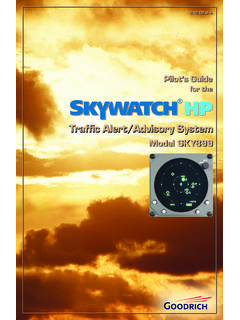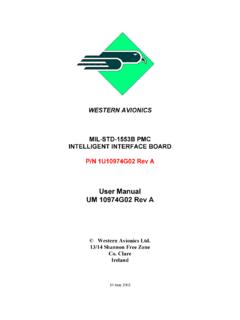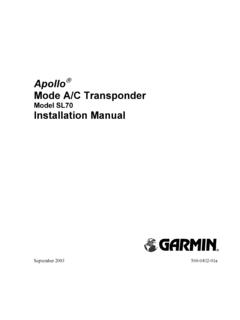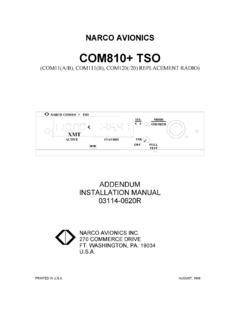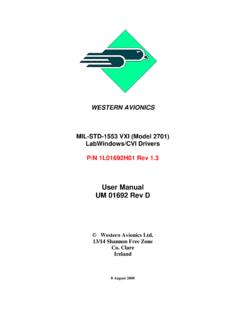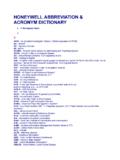Transcription of for the Traffic Alert and Collision Avoidance System I
1 $ Alert and CollisionAvoidance System IPilot s Guidefor theModel TCAS791 Eyes That Never Blink Early TCASIn the early days of flight, when air Traffic was light and slower moving, pilotswere equipped with all they needed for effective Collision Avoidance a sharppair of eyes to scan the today, visual contact is still the surest means of identifying intruder air-craft. But with more Traffic in closer proximity and at higher speeds, today spilots need all the help they can large commercial airliners, this need led to the development of TCAS II( Traffic Alert and Collision Avoidance System II). But that technology hasproved to be too expensive and complex for most regional airlines, business,and general aviation IBFG oodrich avionics Systems, Inc. recognized the need for a viable alterna-tive and developed their TCAS I.
2 The TCAS791 provides most of the capa-bilities of TCAS II, but at a significantly lower cost making it practical forregional airlines, business, and general aviation aircraft. Unlike a TCAS IIsystem, the TCAS791 does not require a mode S transponder and does notissue recommendations to climb or FAA has mandated TCAS I for all part 135 turbine aircraft seating 10 to30 passengers. As a result of TCAS791 s effectiveness, it is becoming thesystem of choice for business and general aviation pilots who want the en-hanced peace of mind that TCAS ExperienceBFGoodrich avionics Systems, Inc. has been involved in the development ofcollision warning programs since the early 1980 s. In 1985, avionics Systemsbegan development of an enhanced Collision warning System for the Navywhich awarded avionics Systems a contract for more than 234 systems to beinstalled in T-34C training largely on the success of the Navy project, avionics Systems was se-lected to validate the specifications for TCAS I under an ARINC contract withthe FAA.
3 The completion of this contract represented yet another first for theTCAS791; it was the first TCAS I to be TSO d, first to receive a full, unre-stricted STC, first to fly, and first to be TCAS791 meets or exceeds all FAA TCAS I requirements and exceedsFAA TCAS I & II specifications for range and bearing success continues the BFGoodrich tradition of aerospace innovation datingto the earliest days of powered flight when BFG supplied tires for the GlennCurtiss pusher. Since then, BFGoodrich has developed a wide range of aerospaceproducts and services including flight instrumentation and TCAS791 Pilot s Guide$ and apparatus disclosed and described herein have been developed solely on company fundsof BFGoodrich avionics Systems, Inc.
4 No government or other contractual support or relationshipwhatsoever has existed which in any way affects or mitigates proprietary rights of BFGoodrich Avion-ics Systems, Inc. in these developments. Methods and apparatus disclosed herein may be subject Patents existing or applied for. BFGoodrich avionics Systems, Inc. reserves the right to add, Copyright 1992, 1993, 1995, 1996, 1999 BFGoodrich avionics Systems, That Never Blink is a trademark of BFGoodrich avionics Systems, and manufactured in the United States of America byTraffic Alert and CollisionAvoidance System IModel TCAS791 Pilot s Guidefor theimprove, modify, or withdraw functions, design modifications, or products at any time without Pilot s GuideSoftware Version InformationAll references in this guide to standby, look up/look down, altitude displaymodes (above, below, and normal), and transmitting from the ground are func-tions of all TCAS791 systems that have software version or higher in theirTransmitter Receiver Computer (TRC).
5 Ignore these references if your TRChas an earlier version of software. (The software version is identified on a tagattached to the back of the TRC.)The following warnings and cautions appear in this guide and are repeatedhere for emphasis:WARNING (pages 2-8 & 2-15)The TCAS791 alone does not ensure safe flight. You muststill visually scan the airspace around your aircraft fre-quently. The TCAS791 relies on information obtained fromtransponders in nearby aircraft. The TCAS791 does not de-tect or track aircraft which are not equipped with an oper-ating ATCRBS (page 2-15)Do not attempt evasive maneuvers based solely on trafficinformation shown on the TCAS791 display. Informationshown on the display is provided to the aircrew only as anaid in visually acquiring Traffic which may impose a colli-sion threat. It is not a replacement for ATC and the See &Avoid (page 2-8)Optimum TCAS791 performance is realized when intruderaircraft are reporting their altitude (via a mode C or otheraltitude reporting transponder).
6 Safety SummaryTable of ContentsPageList of Illustrations .. vList of vChapter 1 System 1-1 General Description .. 1-1 Major Components .. 1-1 Directional Antenna .. 1-1L-Band Omnidirectional Antenna .. 1-1 Transmitter Receiver Computer (TRC) .. 1-2 Control Display Unit (CDU) .. 1-2 Interaction of Major Components .. 1-2 Functional Description .. 1-4 Features .. 1-4 Chapter 2 Operating 2-1 Controls and Indicators .. 2-1 Operating Instructions .. 2-8 Preflight Instructions .. 2-9 Turn On the TCAS791 .. 2-9 Run the Operator-Initiated Self Test .. 2-9 Switch Out of Standby ..2-11 Switch Into Standby .. 2-12 Select the Range .. 2-13 Select the Altitude Display Mode .. 2-13In-Flight Instructions .. 2-13 Switch the Range and Altitude Display Mode .. 2-13 Observe the Display .. 2-14 Respond to Traffic Advisories .. 2-15 Turn On the TCAS791 While in Flight.
7 2-15 Post-Flight Instructions .. 2-15 Turn Off the TCAS791 .. 2-16 Error Messages .. 2-16 TCAS Failed Screens .. 2-16 TCAS Failures .. 2-16 Barometric Input Failures .. 2-17 Maintenance Codes .. 2-17 Chapter 3 Principles of 3-1 Introduction .. 3-1 Traffic Advisory (TA) Criteria .. 3-1 Sensitivity Levels .. 3-2 Sensitivity Level A .. 3-2 Definition .. 3-2 When It s Used .. 3-3 Sensitivity Level B .. 3-3 TCAS791 Pilot s GuideiiiTable of Contents (Continued)PageDefinition .. 3-3 When It s Used .. 3-3 Audio Inhibit, TCAS791 .. 3-3 When It s Used .. 3-3 Audio Inhibit, GPWS .. 3-4TA Symbol Duration .. 3-4No-Bearing TAs .. 3-4 Other Factors That Affect the Display of Traffic Symbols .. 3-4 Ground Target Filtering .. 3-4 Definition .. 3-4 When It s Used .. 3-4 Interference Limiting .. 3-4 Chapter 4 Display 4-1 Introduction.
8 4-1 Chapter 5 5-1 Chapter 6 Warranty 6-1 Introduction .. 6-1 Warranty Statement .. 6-1 Related Policies and Procedures .. 6-2 Table of ContentsTCAS791ivPilot s GuideList of IllustrationsFigureTitlePage1-1 TCAS791 Major Components .. 1-11-2 Typical Screen on the CD605 Control Display Unit (CDU) .. 1-21-3 TCAS791 Simplified Functional Diagram .. 1-31-4 Protection Zones .. 1-52-1 Controls and Indicators .. 2-12-2 Display Ranges on the CD605 .. 2-72-3An Alternate Display w/Photocell & Off-Center Aircraft Symbol . 2-82-4 Startup Screen .. 2-92-5 Standby Screen .. 2-92-6 Test Screen .. 2-102-7 TCAS Failed Screen ..2-112-8 Standby Screen with Maintenance Code .. 2-122-9 Above Display Mode, 10 nmi Range .. 2-122-10 Altitude Display Modes .. 2-142-11 Normal Display Mode, 5 nmi Range .. 2-162-12 TCAS Failed/Barometric Input Screen.
9 2-172-13 Maintenance Code When on the Ground but Not in Standby .. 2-173-1TA Protection Zones if Your Aircraft Has a Radio Altimeter .. 3-24-1 Traffic Advisory and Other Traffic ..4-14-2 Out of Range Traffic Advisory .. 4-14-3No-Bearing Traffic Advisory .. 4-24-4No-Bearing No-Altitude Traffic Advisory .. 4-24-5 Proximity Advisory .. 4-24-6 TCAS Failed Screen .. 4-34-7 TCAS Failed/Barometric Input Screen .. 4-34-8 Standby Screen .. 4-34-9 Out of Standby on the Ground .. 4-4 List of TablesTableTitlePage2-1 Controls and Indicators .. 2-13-1 Ten Situations in Which a Traffic Advisory Will Occur .. 3-15-1 Transmitter Receiver Computer (TRC) Specifications .. 5-15-2CD605 Control Display Unit Specifications .. 5-25-3NY156 TCAS Directional Antenna Specifications .. 5-25-4NY152 L-Band Antenna Specifications .. 5-3 TCAS791 Pilot s GuidevTCAS791 System DescriptionPilot s Guide 1-1 Chapter 1 System DescriptionGeneral DescriptionThe BFGoodrich avionics Systems, Inc.
10 TCAS791 is an airborne Traffic alertand Collision Avoidance System (TCAS I). It monitors the airspace aroundyour aircraft and advises the flight crew where to look for nearby transponder-equipped aircraft that may pose a Collision threat. The TCAS791 is intendedfor use by regional airlines and corporate and general aviation aircraft. Figure1-1 shows the major components of the TCAS791 displays Traffic information on the CD605 Control DisplayUnit (CDU) or on a compatible EFIS or IVSI/TCAS display and generatesaural announcements on the cockpit sound System . Tra ffic information on thedisplay consists of color-coded symbols and text. The type of informationdisplayed depends on the type of intruder aircraft, but generally includes therelative range, bearing, and altitude of intruder aircraft as well as its verticalspeed Pilot s GuideMajor ComponentsThe TCAS791 consists of four major components as described AntennaThe directional antenna transmits omnidirectional transponder interroga-tions and is used as a directional antenna for receiving transponder Omnidirectional AntennaThe L-band omnidirectional antenna receives transponder 1-1.
